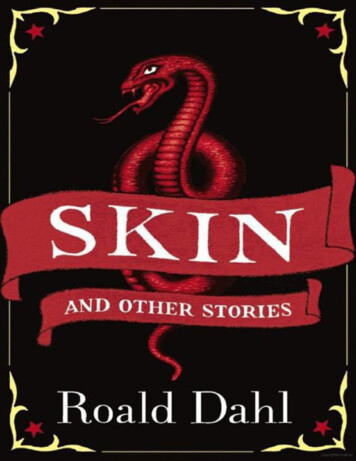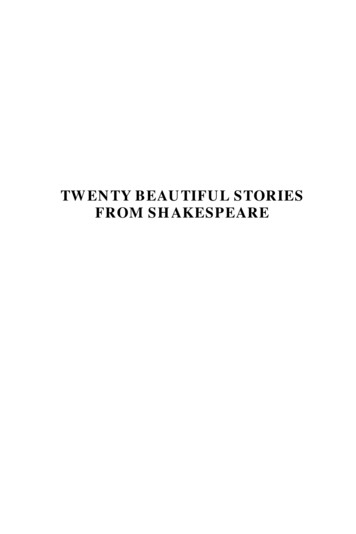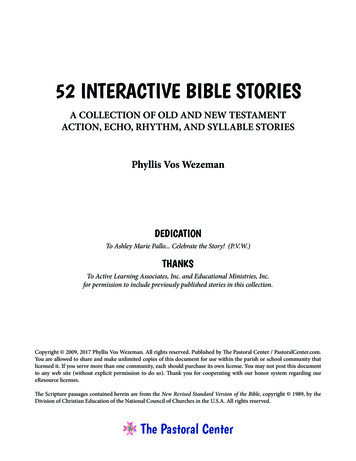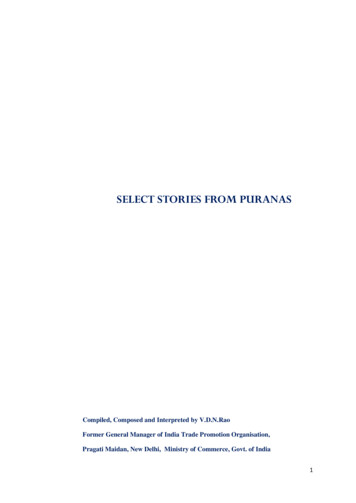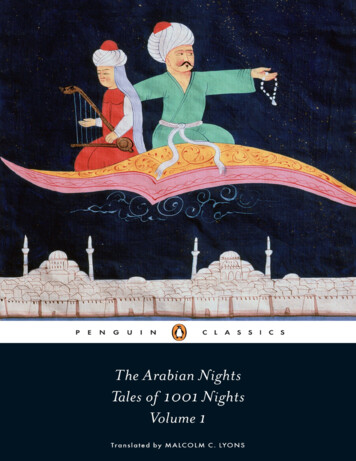
Transcription
DEAR SCIENCEand Other StoriesK AT H E R I N E M c K I T T R I C K
DEAR SCIENCE AND OTHER STORIESMcKittrick ALL FF.indd 111/2/20 12:18 PM
ERRANTRIESA series edited by Simone Browne,Deborah Cowen, and Katherine McKittrickSer ies Editor ia l A dvisory Boa r dJacqueline Nassy Brown, Paul Gilroy,Gayatri Gopinath, Avery Gordon, Richa Nagar,AbdouMaliq Simone, Françoise Vergès,Ruth Wilson Gilmore, and Bobby WilsonMcKittrick ALL FF.indd 211/2/20 12:18 PM
D E A R S C I E N C E and Other StoriesKatherine McKittrickDUKE UNIVERSIT Y PRESS DURHAM AND LONDON 2021McKittrick ALL FF.indd 311/2/20 12:18 PM
2021 Duke University PressAll rights reservedPrinted in the United States of America on acid- f ree paper Designed by Amy Ruth BuchananTypeset in Arno Pro and Trade Gothic by Copperline Book ServicesLibrary of Congress Cataloging-in-Publication DataNames: McKittrick, Katherine, author.Title: Dear science and other stories / Katherine McKittrick.Other titles: Errantries.Description: Durham : Duke University Press, 2021. Series: Errantries Includes bibliographical references and index.Identifiers: lccn 2020016402 (print)lccn 2020016403 (ebook)isbn 9781478010005 (hardcover)isbn 9781478011040 (paperback)isbn 9781478012573 (ebook)Subjects: lcsh: African Americans—Study and teaching. African Americans—Social conditions. Race—Philosophy. AfricanAmerican feminists. Cross-cultural studies.Classification: lcc e185.86 .m355 2021 (print) lcc e185.86 (ebook) ddc 305.896/073—dc23lc record available at https://lccn.loc.gov/2020016402lc ebook record available at https://lccn.loc.gov/2020016403Cover art: Farley Hill National Park, Barbados.Photo by Katherine McKittrick.McKittrick ALL FF.indd 411/2/20 12:18 PM
For Sylvia.For Ellison,again.McKittrick ALL FF.indd 511/2/20 12:18 PM
CONTENTSxiHE LIK ED T O SAY TH AT THIS L OV E WAS THE R ESULT OF A CLINICA L ER ROR1Curiosities (My Heart Makes My Head Swim)14Footnotes (Books and Papers Scattered about the Floor)35The Smallest Cell Remembers a Sound58Consciousness (Feeling like, Feeling like This)71Something That Exceeds All Efforts to Definitively Pin It Down75No Place, Unknown, Undetermined79Notes83Black Ecologies. Coral Cities. Catch a Wave87Charmaine’s Wire91Polycarbonate, Aluminum (Gold), and Lacquer95Black Children99Telephone Listing103Failure (My Head Was Full of Misty Fumes of Doubt)122The Kick Drum Is the Fault125(Zong) Bad Made Measure151I Got Life/Rebellion Invention Groove168(I Entered the Lists)186Dear Science189Notes and Reminders193STORYTELLERS211DIEGESES AND BEARINGSMcKittrick ALL FF.indd 711/2/20 12:18 PM
There is no life that is not geographic.— Ruth Wilson GilmoreMcKittrick ALL FF.indd 911/2/20 12:18 PM
H E L I K E D T O S AY T H AT T H I S L O V E WA ST H E R E S U LT O F A C L I N I C A L E R R O RRay ZilliEllison ZilliSimone BrowneAlexander WeheliyeDina GeorgisRuth Wilson GilmoreCraig GilmoreDemetrius EudellM. NourbeSe PhilipCindi KatzEric LottSammi KingCarmen KynardBarby AsanteKen WissokerNik TheodoreBarrington WalkerKiese LaymonKara KeelingTrish SalahRichard ItonFred MotenLaura HarrisLidia CurtiIain ChambersMarcus Gilroy- WareCharmaine LurchMcKittrick ALL FF.indd 11Ricky VargheseDeb CowenSarah HaleyTreva EllisonNikolas SparksMark V. CampbellNick MitchellBarnor HesseOmiSoore DrydenRazia DawoodAsha TallTia- Simone GardnerDylan RobinsonCora Gilroy- WareSteven OsunaTemi OdumosuLinda PeakeEsther HarveyKaren de SouzaBedour AlagraaKara MeltonKendall WitaszekMaya StitskiDavid ScottAvery GordonJenny BurmanMinelle MahtaniAshon CrawleyBen CarringtonElleza KelleySA SmytheTanya TitchkoskyScott MorgensenAndy KentNik HeynenSharad ChariLaMonda StallingsMecca SullivanGrace Adeniyi- OgunyankinTau LewisVinay GidwaniTerrie Easter SheenShana RedmondSaidiya HartmanErika IbrahimYasmine DjerbalEsther KimDanyel HaughtonYaniya LeeCarl JamesElliott JunKrista FranklinDaniella Rose King11/2/20 12:18 PM
Stephanie SimpsonLiz MillwardOlivia GrossHunter KnightLynn LyKim Khanh TranChanda PrescodWeinsteinSharon Y. RodgersTariq JazeelSandra BrewsterJenny PickerillHazel CarbyAbdouMaliq SimoneDionne BrandBianca BeaucheminSunny KerrAdam Elliott- CooperClyde WoodsKristin MoriahKen HewittFe HewittRomi MorrisonSivamohan ValluvanShana M. GriffinKate MarinerPrinceScott RutherfordRenée GreenLeslie SandersJoshua TranenErrol NazarethRicha NagarCarolyn ProuseJessica RyanCarole BoyceDaviesJacqueline NassyBrownBrittany MechéDarcel BullenJade BrooksRobin D. G. KelleyBeverley MullingsLisa LoweVron WarePaul GilroySylvia WynterIhave been experimenting with these and other stories for a longtime. Thank you to the many students, faculty, staff, who invitedme to share these ideas, as well as colleagues and friends who participated in panels, symposia, workshops, conversations. The feedbackhas been, and is, invaluable, admired, and appreciated. Many thanks toall those who administered and arranged travel, accommodations, andday- to- day activities during visits elsewhere. The referee comments arecherished. The readers encouraged me to think with and through thisproject and imagine sites- citations unseen. My parents, Valerie Brodrickand Robert McKittrick, have provided decades of support and love forwhich I am grateful. In addition to camaraderie and an indescribable critical eye, Simone Browne read a few iterations of Dear Science — thank youfor taking the time to support these stories in a world that effaces blacktime. Ruthie Gilmore offered generosity, notes, time, stories, space, futures, friendship. Sylvia Wynter’s conversation, kindness, and commitment to black intellectual life is admired, always. Zilli, endlessly curiousand studied, provided scaffolding, contexts, walls, shelves, books, writings, ideas, love, photographs, songs, codes, mechanics, guitar tabs, notations, grooves that are immeasurable. Shortcomings weigh; the imperfections within are all mine. There are songs and musicians referencedthroughout these stories and, still, the blap- zomp- tonk is unsatisfactorilyxiiHe Liked to Say That This LoveMcKittrick ALL FF.indd 1211/2/20 12:18 PM
tracked and remains somewhat quiet and unlisted. I appreciate the musicians who interrupted and complemented these stories as well as thedozens of friends and colleagues who provided recommendations, sharedsongs and albums, and passed on playlists and car tapes (for the latter I amindebted to Cam McKittrick). These stories were, in part, supported bythe Social Science and Humanities Research Council (Insight Development Grant and Insight Grant) as well as the Antipode Foundation.Was the Result of a Clinical ErrorMcKittrick ALL FF.indd 13xiii11/2/20 12:18 PM
CURIOSITIES (MY HEART MAKES MY HEAD SWIM)Dear Science and Other Stories is a collection of ideas I have beengathering since about 2004.1 The project began as a curiosity. Iwas originally interested in how race is attended to in feministscience and technology studies and how black feminists and black scholars work through the thorny racial privileges and biases that animate thisfield. My contribution to this conversation was to center black creatives(poets, musicians, visual artists) and think through how they attend toscience in their work. I sat with June Jordan’s kerosene and irradiation andphosphorescence.2 I sat with the kerosene and irradiation and phosphorescence not to discount scientific racism and biological determinism, butto ask questions about how black worlds are not always wholly defined byscientific racism and biological determinism. I sought to draw attentionto how black creatives work with scientific concepts in innovative and humanizing ways — attentive to racism, yes, but not understanding scientific racism as the only way to define black life.3 This was complementedThe title of this story, “My Heart Makes My Head Swim,” is from Frantz Fanon’s Black Skin,White Masks, trans. Charles Lam Markmann (1952; rpt., New York: Grove, 1967), 140.1. The title of this collection of stories, Dear Science, is borrowed from tv on the Radio,Dear Science, Interscope, 2008.2. June Jordan, “Inaugural Rose,” in Directed by Desire: The Collected Poems of June Jor dan, ed. Jan Heller Levi and Sara Miles (Port Townsend, WA: Copper Canyon Press, 2007),297.3. I shy away from black science fiction and Afrofuturism and, for the most part — whenaddressing science specifically — settle on exploring the ways black creatives engage scienceoutside these genres. Although this list is a too- small sample of the expansive work in blackscience fiction, black speculative fiction, and Afrofuturism, see Kodwo Eshun, “FurtherConsiderations of Afrofuturism,” cr: The New Centennial Review 3, no. 2 (Summer 2003):McKittrick ALL FF.indd 111/2/20 12:18 PM
by ongoing research on Sylvia Wynter’s “demonic model,” which she discusses in her essay “Beyond Miranda’s Meanings,” and the concepts of“autopoiesis” and “science of the word,” which she takes up in a numberof her essays. The demonic model, taken from physics, is used by Wynterto think about the intellectual and conceptual ground through which Caribbean women recalibrate the meaning of humanity. “Autopoiesis” is aterm developed by biologists Humberto Maturana and Francisco Varela.It is used by Wynter to show that we invest in our present normative modeof existence in order to keep the living- system — our environmental andexistential world — as is. This is a recursive logic; it depicts our presentlyecocidal and genocidal world as normal and unalterable. Our work is tonotice this logic and breach it. Wynter’s extension of Aimé Césaire’s “science of the word,” speaks to interdisciplinarity, dislodging our biocentricsystem of knowledge, and showing that the natural sciences, the humanities, and the social sciences are, when thought together, generative sitesof inquiry.4 In using concepts such as these — scientific terms that are notcast as purely and objectively scientific yet retain within them traces ofthe hard sciences — Wynter theorizes race outside raciology and positionsblackness and black studies as an analytics of invention. My curiosity ledme to think about the humanizing work black creatives illuminate in theirscientifically creative and creatively scientific artworlds, while also drawing attention to the disruptive work that black feminists and black schol387 – 402; André M. Carrington, Speculative Blackness: The Future of Race in Science Fiction(Minneapolis: University of Minnesota Press, 2016); and Sami Schalk, Bodyminds Reimag ined: (Dis)ability, Race, and Gender in Black Women’s Speculative Fiction (Durham, NC: DukeUniversity, 2018).4. Sylvia Wynter, “Beyond Miranda’s Meanings: Un/Silencing the ‘Demonic Ground’of Caliban’s ‘Woman,’ ” in Out of the Kumbla: Caribbean Women and Literature, ed. CaroleBoyce Davies and Elaine Savory Fido (Trenton, NJ: Africa World Press, 1990), 355 – 372; Sylvia Wynter and Katherine McKittrick, “Unparalleled Catastrophe for Our Species? Or, toGive Humanness a Different Future: Conversations,” in Sylvia Wynter: On Being Human asPraxis, ed. Katherine McKittrick (Durham, NC: Duke University Press, 2015), 9 – 89. Seealso Aimé Césaire, “Poetry and Knowledge,” in Lyric and Dramatic Poetry, trans. ClaytonEshleman and Annette Smith (Charlottesville: University Press of Virginia, 1990), xlii – lvi.A biocentric system of knowledge that assumes we are, totally and completely and purely,biological beings, beholden to evolution and its attendant teleological temporalities, ratherthan humans who are physiological- story- makers, both bios and mythoi, who produce fictive evolutionary stories about our biological selves. “Biocentric” is defined numerous timesthroughout this text, although the explanation in the story “(Zong) Bad Made Measure” isthe most comprehensive.2Curiosities (My HeartMcKittrick ALL FF.indd 211/2/20 12:18 PM
ars do (as they breach the recursive field of feminist science and technology studies and other disciplines).I share Dear Science not as a project that describes science, particularlyblack science, through (or as) scientific racism, but as a study of how wecome to know black life through asymmetrically connected knowledgesystems. Science is present — it is tied to the curiosities noted above — butit is restless and uncomfortably situated and multifarious rather than definitive and downward-pressing.5 This is a book about black livingnessand ways of knowing. This shift — from studying science to studying waysof knowing — has allowed me to work out where and how black thinkersimagine and practice liberation as they are weighed down by what I canonly describe as biocentrically induced accumulation by dispossession.The weight is important here, because it signals not simply a monumental system of knowledge that is fueled by colonial and plantocratic logics,but the weight that bears down on all black people, inside and outside theacademy, and puts pressure on their physiological and psychic and political well- being. Dear Science takes into account how black intellectual lifeis tied to corporeal and affective labor (flesh and brains and blood andbones, hearts, souls) by noticing the physiological work of black liberation. These labors are, however, impossible to track and capture with precision. In noticing the physiological work of black liberation, I am askingfor a mode of recognition that does not itemize- commodify black liberation and black embodied knowledge. Indeed, tracking down (quantifying and/or endlessly describing) black corporeal and affective and physiological labor belies the kinds of black studies these stories tell. For thisreason, affective- physiological- corporeal- intellectual labor, within thistext, is momentary and somewhat erratic; I imperfectly draw attentionto how seeking liberation, and reinventing the terms of black life outsidenormatively negative conceptions of blackness, is onerous, joyful, and difficult, yet unmeasured and unmeasurable. Mnemonic black livingness.My heart makes my head swim.65. Dear Science works with scientia (knowledge) in its most general sense. Science (biology, math, physics, and so on) animates scientia, but science (testable materials, systematicmethods that result in explanation, experiments and predictions and discoveries) is not thecentral preoccupation of Dear Science. Science is a shadow, a story, a friendship. Science reveals failed attachments.6. Fanon, Black Skin, White Masks, 140.Makes My Head Swim)McKittrick ALL FF.indd 3311/2/20 12:18 PM
WONDERWithin, I share a series of interdisciplinary stories that are indebted to anticolonial thought and black studies. Dear Science argues that black people have always used interdisciplinary methodologies to explain, explore,and story the world, because thinking and writing and imagining across arange of texts, disciplines, histories, and genres unsettles suffocating anddismal and insular racial logics. By employing interdisciplinary methodologies and living interdisciplinary worlds, black people bring togethervarious sources and texts and narratives to challenge racism. Or, blackpeople bring together various sources and texts and narratives not to capture something or someone, but to question the analytical work of capturing, and the desire to capture, something or someone. The stories thinkthrough how racism and other forms of oppression underpin the political economy of academic and nonacademic disciplinary thinking (the demand to gather and live with seemingly transparent data, in a range of sectors; living with data [policies, reports, cards and carding] that ostensiblyprove that those communities living outside normalcy are verifiably outside normalcy; giving over the data in exchange for capital). Within blackstudies and anticolonial studies, one can observe an ongoing method ofgathering multifariously textured tales, narratives, fictions, whispers,songs, grooves. The textures offer one way to challenge the primacy ofevidentiary and insular normalcies, because they are allegedly incongruous. In assembling ideas that are seemingly disconnected and uneven (theseabird and the epilogue, the song and the soil, the punch clock and theecosystem, the streetlight and the kick- on- beat), the logic of knowing- to- prove is unsustainable because incongruity appears to be offering atypicalthinking. Yet curiosity thrives. The industry punch clock calibrates and recalibrates the ecosystem (water . . . rich in corrosive chemicals purged fromthe factories of its industrial past) and . . .7 She asks: What happens whenour blood falls to the soil and seeps in? She wonders: What happens toour conception of land when it is an absorbent receptacle for black people’s erythrocytes, leukocytes, thrombocytes? She answers: Strange fruit.87. Malini Ranganathan, “Thinking with Flint: Racial Liberalism and the Roots of anAmerican Water Tragedy,” Capitalism Nature Socialism 27, no. 3 (2016): 18.8. Danyel Haughton, your question still sits with me. See also Katherine McKittrick,“Plantation Futures,” Small Axe 17, no. 3 (November 2013): 1 – 15; Billie Holiday, “StrangeFruit,” Commodore, 1939.4Curiosities (My HeartMcKittrick ALL FF.indd 411/2/20 12:18 PM
Agony. Also, assembling ideas that are seemingly connected (the weightand the measure, the cloth and the silk, the road and the vehicle) fuse andbreak apart how we know, because we seek out continuities and ruptures.And curiosity thrives. The weight (pull of gravity) and measure (calculation) are overlapping and different (uncommon weight/uncommonweight/new weight . . . water parts) and . . .9 What is meaningful, then,are the ways in which black people are interdisciplinary actors, continually entangling and disentangling varying narratives and tempos and huesthat, together, invent and reinvent knowledge. This interdisciplinary innovation illuminates, to borrow from Mark V. Campbell, multiple skillsand ways of knowing that privilege collaboration and bring into view unorthodox practices of belonging that discredit ethnic absolutism and its attendant geographic fictions.10This is a way of living, and an analytical frame, that is curious and sustained by wonder (the desire to know). This is a method that demandsopenness and is unsatisfied with questions that result in descriptive- data- induced answers. Black studies and anticolonial thought offer methodological practices wherein we read, live, hear, groove, create, and writeacross a range of temporalities, places, texts, and ideas that build on existing liberatory practices and pursue ways of living the world that areuncomfortably generous and provisional and practical and, as well, imprecise and unrealized.11 The method is rigorous, too. Wonder is study.Curiosity is attentive. Black method is therefore not continuously andabsolutely undisciplined (invariably without precision, invariably undone).12 Black method is precise, detailed, coded, long, and forever. Thepractice of bringing together multiple texts, stories, songs, and places involves the difficult work of thinking and learning across many sites, andthus coming to know, generously, varying and shifting worlds and ideas.9. M. NourbeSe Philip, Zong! (Toronto: Mercury Press, 2008), 55 – 56, 59.10. Mark V. Campbell, “Everything’s Connected: A Relationality Remix, a Praxis,” C. L. R.James Journal 20, no. 1 (2014): 97 – 114. See also Paul Gilroy, The Black Atlantic: Modernity andDouble Consciousness (Cambridge, MA: Harvard University Press, 1993).11. Ruth Wilson Gilmore, “Abolition Geography and the Problem of Innocence,” in Fu tures of Black Radicalism, ed. Gaye Theresa Johnson and Alex Lubin (New York: Verson,2017), 225 – 240; AbdouMaliq Simone, Improvised Lives (Cambridge, MA: Polity, 2019).12. To be totally undisciplined can perhaps undermine the intellectual labor of black people who rigorously and generously share and build and remember stories and lessons that wecollectively utilize as we move through this world. We are not always undone. Our undoingis practiced, patient, focused.Makes My Head Swim)McKittrick ALL FF.indd 5511/2/20 12:18 PM
Sometimes this is awful because we are gathering dense texts and uncomfortable ideas that wear us out. Sometimes this is awful because we areaware we cannot know forever, yet we are committed to the everlastingeffort of figuring out how we might, together, fashion liberation. We haveno time. This rigor is animated by diasporic literacy, VèVè Clark’s wonderfully useful reading practice that investigates and shows how we already do, or can, illuminate and connect existing and emerging diasporiccodes and tempos and stories and narratives and themes. Clark showshow diasporic literacy is structured through “recognized references sharing a wealth of connotations.”13 She theorizes Mayotte Capécia, Mahalia Jackson, Jomo Kenyatta, food, furnishings, and laughter as grammars,figures, and practices that are written into creative- intellectual texts asprompts.14 These literacies function to expand the text outside itself (theprompt opens a door). Kenyatta and laughter are not endlessly explainedand unpacked; instead, they cue what does not need explanation but requires imagination and memory and study. Diasporic literacy signalsways of being and ways of living (memories, imaginations, mnemonics),that we know and share in order to collectively struggle against suffocating racial logics. Like sorrow songs. Like freedom dreams. Like erotic.Like flying cheek- bones.15STORYThe ideas and curiosities gathered in Dear Science are bundled and presented as stories. Telling, sharing, listening to, and hearing stories are relational and interdisciplinary acts that are animated by all sorts of people,places, narrative devices, theoretical queries, plots. The process is sustained by invention and wonder. The story has no answers. The storiesoffer an aesthetic relationality that relies on the dynamics of creating- narrating- listening- hearing- reading- and- sometimes- unhearing. The sto13. VèVè Clark, “Developing Diaspora Literacy: Allusion in Maryse Condé’s Hérémak honon,” in Out of the Kumbla: Caribbean Women and Literature, ed. Carole Boyce Davies andElaine Savory Fido (Trenton, NJ: Africa World Press, 1990), 308 – 309.14. Clark, “Developing Diaspora Literacy,” 308 – 309.15. W. E. B. Du Bois, The Souls of Black Folk (1903; rpt., New York: Vintage, 1990); RobinD. G. Kelley, Freedom Dreams: The Black Radical Imagination (Boston: Beacon, 2002); Audre Lorde, “Uses of the Erotic: The Erotic as Power,” in Sister Outsider (Berkeley, CA: Crossing Press, 1984), 53 – 59; M. NourbeSe Philip, She Tries Her Tongue, Her Silence Softly Breaks(Charlottetown, Canada: Ragweed Press, 1989), 51 – 53.6Curiosities (My HeartMcKittrick ALL FF.indd 611/2/20 12:18 PM
ries do not offer lucid tales or answers; rather, they signal ways of livingin a world that denies black humanity (or, more aptly, the stories signalways of black livingness).16 The story- text itself, read aloud or quietly, isan imprint of black life and livingness that tells of the wreckage and thelists and the dance floors and the loss and the love and the rumors andthe lessons and the heartbreak. It prompts. The story does not simply describe, it demands representation outside itself. Indeed, the story cannottell itself without our willingness to imagine what it cannot tell. The storyasks that we live with what cannot be explained and live with unexplainedcues and diasporic literacies, rather than reams of positivist evidence. Thestory opens the door to curiosity; the reams of evidence dissipate as wetell the world differently, with a creative precision. The story asks that welive with the difficult and frustrating ways of knowing differentially. (Andsome things we can keep to ourselves. They cannot have everything. Stopher autopsy.) They cannot have everything.I present Dear Science as a series of stories as a way to hold on to the rebellious methodological work of sharing ideas in an unkind world. Sharing can be uneasy and terrifying, but our stories of black worlds and blackways of being can, in part, breach the heavy weight of dispossession andloss. Our shared stories of black worlds and black ways of being breach theheavy weight of dispossession and loss because these narratives (songs,poems, conversations, theories, debates, memories, arts, prompts, curiosities) are embedded with all sorts of liberatory clues and resistances(PFUnk/f.u.n.k.).17 Sharing, therefore, is not understood as an act ofdisclosure but instead signals collaboration and collaborative ways to enact and engender struggle. As a collection of stories, too, Dear Science understands theory as a form of storytelling. Stories and storytelling signalthe fictive work of theory. I hope this move, at least momentarily, exposes16. Barbara Christian writes: “I am inclined to say that our theorizing (and I intentionally use the verb rather than the noun) is often in narrative forms, in the stories we create,in riddles and proverbs, in the play with language, because dynamic rather than fixed ideasseem more to our liking. How else have we managed to survive with such spiritedness theassault on our bodies, social institutions, countries, our very humanity?” Barbara Christian,“The Race for Theory,” Feminist Studies 14, no. 1 (Spring 1998): 68. See also Saidiya Hartman on “critical fabulation,” in “Venus in Two Acts,” Small Axe 12, no. 2 (June 2008): 1 – 14.Hazel V. Carby’s Imperial Intimacies: A Tale of Two Islands (London: Verson, 2019) is, forme, a beautiful and creative work that offers a mode of storytelling that captures and bendsdisciplined- i nterdisciplined genres.17. Listen to Prince, “F.U.N.K.,” NPG Digital, 2007.Makes My Head Swim)McKittrick ALL FF.indd 7711/2/20 12:18 PM
the intricacies of academic work where fact- fi nding, experimentation,analysis, study, are recognized as narrative, plot, tale, and incomplete inventions, rather than impartial treatises. As story, theory is cast as fictiveknowledge and insists that the black imagination is necessary to analytical curiosity and study. Story is theoretical, dance, poem, sound, song,geography, affect, photograph, painting, sculpture, and more. Maybe thestory is one way to express and fall in love with black life. Maybe the storydisguises our fall.Kevin Young offers a rich analysis of black stories, storying, storytelling, and story- making. He outlines how black stories can be acts of keeping something or someone or somewhere hidden (desire, love, half of thestory, where it’s at, kin). He also addresses how the practice of twistingstories and narratives (lying, counterfeiting, remapping, recoding, forging) subverts, refuses, and resists racism.18 Thus, the work of telling andthe story itself enmesh, to offer not a descriptive tale but a strategic lessonin and for black life. With this in mind: the content of the story is a lesson(you, we, recode and forge and invent, this is how we live, I will keep yoursecret); the act of teaching and telling the story is collaborative (I willshare this with you, coauthor this with you, and live this life with you, Iwill tell you my secret); the contents of the story are multifarious and interdisciplinary (characters, plots, twists, metaphors, unexplained codes,places, secrets, connotations, structure the lesson and telling). The lesson, the telling, the contents, are ways of life (ways of being). The story,too, Dina Georgis writes, has the capacity to affectively move us and, atthe same time, incite a listening practice that is “neither disengaged norwanting to master what it sees and hears.”19 If the function of the storyis to invite the reader- v iewer- interlocutor- listener to feel, respond, andbe moved, it also, Ruth Wilson Gilmore reminds us, establishes powerful alignments (provisional and not) that are put to work with and forloved ones.20 Gilmore shows how utilizing various narrative devices andreading across materials (photocopies, pamphlets, newsletters, scripture, statistics, drawings, announcements, charts, legal documents andcases, theories) engenders practices of solidarity and collaboration that18. Kevin Young, The Grey Album: On the Blackness of Blackness (Minneapolis: Graywolf, 2012).19. Dina Georgis, The Better Story: Queer Affects from the Middle East (New York: sunyPress, 2013), 1, 18.20. Ruth Wilson Gilmore, Golden Gulag: Prisons, Surplus, Crisis, and Opposition in Glob alizing California (Berkeley: University of California Press, 2007).8Curiosities (My HeartMcKittrick ALL FF.indd 811/2/20 12:18 PM
work within existing, and imagine new, geographies of liberation.21 Thestory, as interdisciplinary method, is thus tasked with immense andhopeful possibilities. The story is the practice of black life. With and forlove. In this way, and as an interdisciplinary methodology, the story —theoretical, creative, groovy, skilled, action- based, secreted, shared — is averb- activity that invites engagement, curiosity, collaboration.SIMULTA NEI T YSylvia Wynter writes that we are a “storytelling species,” while also observing that our stories — especially our origin stories — have an impacton our neurobiological and physiological behaviors.22 Her observationsdraw attention to the natural sciences as well as interdisciplinarity, emphasizing a dynamic connection between narrative and biology (storieshave the capacity to move us). In addition to contesting a teleological- biocentric genre of the human, the dynamism between biology and narrative affirms the black methodologies noted above: science and story arenot discrete; rather, we know, read, create, and feel science and story simultaneously.23 Or, we tell and feel stories (in our hearts), and this telling- feeling tells- feels the empirics of black life. Reading across our curiosities,the story and imagination are testimonies grounded in the material expression of black life. The story has physiological components. And stories make place.24 This means the metaph
3. I shy away from black science fiction and Afrofuturism and, for the most part—when addressing science specifically —settle on exploring the ways black creatives engage science outside these genres. Although this





